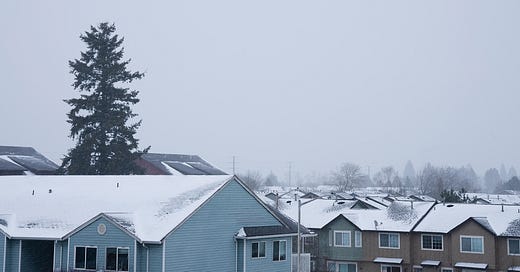Welcome to the twenty-first edition of Full Stack Creator! Hope you didn’t lose power during the storms that blasted most of the US.
I write this while looking out my balcony window onto a white, beautifully cold neighborhood. The PNW, like most of the US, was hit by numerous winter storms within a few days. This is not normal for the area but very welcome. This did get me thinking about something though. When we are forced to adjust our approach, due to outside factors, does it always yield a worse result? In the literal sense, I am talking about snow and the ability to leave the house. But metaphorically, I am talking about constraints during the creative process. Today, we will talk about constraints and if they yield a better result than being able to make without limits. Last week's letter touched on this slightly, but we will go deeper today.
We’ll start with the definition of a constraint:
the state of being checked, restricted, or compelled to avoid or perform some action
https://www.merriam-webster.com/dictionary/constraint
At first glance, constraints look and feel like something blocking the creative process. I used to only see it this way too, but after working in the tech space with customer requirements and guidelines, you eventually grow to accept them, maybe even like them. During the day-to-day of my job, I am a product manager and lead a design team. I provide constraints and guidelines daily. My team, like most in the space, has built out a design system. This system accounts for 90%+ of our SaaS products' capabilities. A design system is essentially a group of guidelines and constraints to build with. It can account for colors, fonts, small components, groups of components, and entirely built screens. This allows designers — product, UX, UI, etc, to make without the friction of smaller decisions. If the website needs a new page or the app needs a new screen, they can focus on the overall experience, rather than color or button size. Additionally, this leads to a more consistent product, where the same things are recycled. This allows the user's experience to be clearer and with less friction.
This idea is also adapted to other creative mediums. It might not be so black and white as it is in design, but there are constraints nonetheless. Developers are posed with the constraints of the software language they code in or even the hardware their code runs on. Filmmakers and photographers are usually constrained by gear, location, or talent.
I provided examples of past constraints in last week's letter — relating to how it has affected the documentary I am shooting. I use the term "shooting" loosely. In my case, time and the pandemic are my constraints. I have a much shorter window to produce the final product, but I am also not able to shoot any of this in person, by hand. I am instead shooting this over video chat and faking b-roll. I don’t know if this will produce a better final version, but it will produce a more creative one!
I’ve had a process for a while now. I know what gear I like to use, either owned or rented. I know my shooting, lighting, and audio process. This has allowed me to have a consistent look. Right there in itself was a constraint, one that I purposely inflicted. I wanted consistency in my tools and process, so I could focus on the stories I tell.
This project has thrown a curveball, one that I created new constraints for. I could technically shoot a few of the interviews in person, but would I risk someone's health or safety? I made an intentional decision to constrain myself to remote only. By setting this constraint I had to rethink what I considered production.
How would interviews take place?
How would I shoot b-roll?
Would video call quality be good enough?
Does video and audio quality weigh enough on the overall narrative?
Another thing I had to consider was I had already ordered all the gear needed to produce these films in person. This was thousands of dollars of rentals. Should I return them and salvage some of my money or keep them and shoot something with all of it?
The constraints I set were the following:
All interviews were to be held remotely.
If the interviewee had quality gear, I would leverage that. If not, I would prompt them to use their smartphone, if that friction point was not too high.
Due to it being remote, I had to build a process around the remote interview. I had to make documentation for the interviewees, so they knew what to expect.
I asked all interviewees if they would be able to provide b-roll.
I decided I would not return the gear.
I would use this gear to create as much b-roll as I could that added to the narrative. I would also shoot some cinematic scenes to help tell the story.
There is a hard stop date to interviews.
There are hard deadlines for each documentary. Four are to be produced.
So far these constraints have been great! Yes, I would love to shoot these in person. Yes, I’d love better quality video and audio. But the story should be the same.
By setting constraints for this series, I was able to provide a path to a project that seemed to have gone off the rails. This process is not perfect for everything, but it can be very useful if your creative process or project is running away from you. Remember the main goal of making is to finish the project. Constraints will help you finish.
Examples of design systems:
Microsoft Fluent: https://www.microsoft.com/design/fluent/#/
Adobe Spectrum: https://spectrum.adobe.com
Spotify Encore: The story of how and why they created it https://spotify.design/article/reimagining-design-systems-at-spotify
Here is a quick film I made after the storm passed through:



